- Home
- Michael Newton
The Texarkana Moonlight Murders: The Unsolved Case of the 1946 Phantom Killer Page 5
The Texarkana Moonlight Murders: The Unsolved Case of the 1946 Phantom Killer Read online
Page 5
* * *
Nor were the Rhythmaires alone in their reaction to the city’s second double murder in as many months. Rather surprisingly, the Griffin-Moore murders in March had barely fazed local teenagers. A half-century on, Jerry Atkins told the Texarkana Gazette, “It made no impact at all. I was a kid and didn’t read the newspapers. I don’t remember my parents being afraid either, not until the second murders. “ Another local teen recalled, “I didn’t pay any attention to it.”40 Texarkana was a rough town where people died in unpleasant ways, and mayhem was taken for granted. Few locals had connected February’s non-fatal attack to the killings of March 23, and it seems that none—police included—had expected the crime to be repeated.
When it was, everything changed. As Arkansas State Trooper Milton Mosier recalled, “After Spring Lake Park, everything mushroomed from there.”41 Jerry Atkins, for one, was having second thoughts. “As I was questioned about possibly identifying anyone who was at the VFW Club on that fatal night,” he later recalled, “I began to think about the Moore-Griffin murders as well. Their car and bodies were found not too far from the Highway 67 spot called Club Dallas. Could someone have stalked them from there? Maybe there was someone at the VFW who saw Betty Jo with Paul.”42
Perhaps. But no one stood out from the crowd as a suspicious character. If anyone had trailed Martin and Booker from the dance, he did so unobserved. Local authorities had no leads to direct them in their manhunt.
But help was on the way.
Chapter 5
Lone Wolf
Texarkana’s second double murder sent shock waves through the community. Panic set in, clearing the streets of residents who normally enjoyed the city’s night life. Neighbors looked askance at one another, while overt hostility awaited strangers passing through the normally hospitable community. Although the killer only seemed to hunt on lover’s lanes, the frightened residents of Texarkana barricaded homes against the prospect of intruders. Hardware stores sold out of guns and ammunition, dead-bolt locks, and screen-door braces. Some home owners rigged makeshift alarms from pots and pans, an early warning system if the gunman came to call.1
Years later, W. E. Atchison—a sixteen-year-old on the Texas side of State Line Avenue in 1946—told the Gazette, “If you wanted to go to someone’s house after dark, you had to call them first and let them know you were coming.” The alternative was being shot. Imogene West, later Miller County’s treasurer, described one harrowing incident to reporter Greg Bischof. “I was a country girl who came to the big city of Texarkana from Nevada County,” she said. One night during the terror, her husband Harold spied a prowler peeping through a window of their home, at the corner of East Third and Walnut Streets. He grabbed a gun and rushed to the kitchen door, but while he struggled with the latch, his weapon fired accidentally. Thankfully, no one was hit. The still-unknown prowler escaped.2
* * *
Police in postwar Texarkana had no “usual” response for serial murder—nor, in fact, did any of their colleagues in the rest of the United States. Over the past four decades, larger, better-trained police departments had been baffled by a host of homicidal maniacs: “Jack the Ripper” slayers in Atlanta (1911) and Manhattan (1915); the Axeman of New Orleans (1918–19); the “Toledo Clubber” (1925); New York City’s “3X” killer (1930); and Cleveland’s “Mad Butcher of Kingsbury Run” (1934–38). In rural America, axe-wielding home-invaders had claimed twenty-six lives in six attacks spanning as many Midwestern states, between September 1911 and December 1912. Meanwhile, during those same two years, another forty-nine victims were killed in similar nocturnal raids across Texas and Louisiana. It appeared, to some, that sheer insanity had gripped America, and that authorities were ill-equipped to deal with it.
But that would not prevent them giving it a try.
Texarkana’s second double murder within three weeks’ time brought law enforcement officers galore into the border city. On the Lone Star side, those catalogued in various reports included seven additional Texas Rangers, four “technical experts” from the Texas Department of Public Safety’s Bureau of Identification and Records, and eight Highway Patrolmen.3 All would play a part in the investigation, but the uncontested star of the show was ranger captain Manuel Trazazas “Lone Wolf” Gonzaullas.
* * *
In the pantheon of ranger officers renowned for colorful exploits, Gonzaullas was unique. For starters, he was born in Spain—at Cadiz, on July 4, 1891—to a Spanish father and Canadian mother of German descent. Both were naturalized American citizens, living in Texas but visiting Spain at the time of Manuel’s birth.4 Growing up in Texas at the turn of the century, Gonzaullas experienced tragedy—bandits killed his two brothers and wounded both of his parents when he was fifteen5—and he idolized another Texas Ranger captain, “Border Boss” John Reynolds Hughes, described by biographer W. W. Sterling as possessing “every requisite of a great captain: initiative, courage, intelligence and judgment. He loved the Service. One of the axioms he used in enlisting his men ... was ‘Nerve without judgment is dangerous, and has no place in the Ranger Service.’” Retired after twenty-eight years of man-hunting, in 1915, Hughes became a successful banker but finally found life without a badge unbearable, committing suicide in Austin on June 3, 1947.6
Despite his admiration for the Texas Rangers, Manuel Gonzaullas tried other paths before following in Hughes’s footsteps. At age twenty, in 1911, he wangled an appointment as a major in the Mexican army. Biographer Brownson Malsch mentions the fact in passing, but provides no details and offers no clue to how long Gonzaullas served south of the border.7 At the time of his enlistment, Mexico was embroiled in a bloody revolution that would span a decade and depose eleven heads of state, with two of those assassinated.8 Sadly, no record has survived detailing what Gonzaullas did during the revolution, or which battles—if any—he may have witnessed.
We do know that he made it back to the United States, alive and well, by 1915—when, at some point never specified, he joined the U.S. Treasury department as a “special agent.” Once again, Malsch keeps the details sparse and vague, reporting only that Gonzaullas received “intensive training ... at Washington and New York” in the fine points of ballistics and handwriting analysis, after which he was “intimately involved in investigative work.”9
Where? Doing what, exactly?
In 1915, Treasury offered only two possibilities: the Secret Service, founded in 1865, or the Bureau of Internal Revenue, created in 1877. Both agencies pursued violators of federal law, with the Secret Service focused on counterfeiters and any other “persons perpetrating frauds against the government,” while the revenuers hunted tax dodgers. At various times and places, overlapping jurisdiction found both units battling distillers of illegal, untaxed liquor—a job that assumed overriding importance with the advent of national prohibition in January 1920.10
Ten months after America went “dry,” on October 1, 1920, Gonzaullas joined the Texas Rangers in El Paso. He was twenty-nine years old, and ready to become a living legend. Soon, he earned the nickname of El Lobo Solo—“The Lone Wolf”—because, as he explained, “I went into lots of fights by myself, and I came out by myself, too.”11 Some accounts credit him with personally killing seventy-five outlaws, a figure Gonzaullas dismissed as “a gross exaggeration.” He did not quibble when others pegged the body-count at thirty-one, but refused to offer a number himself. “Let’s just say there were several,” he told Brownson Malsch. “I don’t like to dwell on it. I did it only to protect my own life, or property, and only to enforce the law.”12 One shooting, of a Jefferson County elected official in July 1922, resulted in a murder charge against Gonzaullas, but the court accepted his self-defense plea and directed a verdict of acquittal.13
Throughout the Roaring Twenties and into the Great Depression, Gonzaullas patrolled the Rio Grande border and adjacent oil fields, riding herd on moonshiners and rum-runners, gamblers and prostitutes, narcotics traffickers and bandits who had trad
ed their horses for automobiles, their six-shooters for Thompson submachine guns. His most famous town-taming campaign was waged in Kilgore, Texas, during 1931.
Once a thriving agricultural community, founded in 1872, Kilgore had been crippled by falling cotton prices and the advent of depression after 1929. Within a year, its population had declined 50 percent, and most of those who still remained had plans to leave before the town dried up and blew away. Then, on October 3, 1930, wildccatter Columbus “Dad” Joiner struck oil at nearby Henderson, marking discovery of the vast East Texas Oil Field spanning 140,000 acres, swiftly sprouting 30,340 oil wells. More than 1,100 of those wells stood within Kilgore’s city limits, and the dying berg became a boom town, with all that implied for rampant lawlessness.14
Six months into the boom, local lawmen found themselves unable to keep order in Kilgore, a constantly expanding settlement of muddy streets, tents and shanties, honky-tonks, brothels, and gambling dens. In desperation, they sought help from Texas Rangers, and one of those who answered the call was Lone Wolf Gonzaullas. On arrival, backed by Ranger J. P. Huddleston, Gonzaullas warned the wild town’s residents, “Crime may expect no quarter in Kilgore. Gambling houses, slot machines, whiskey rings and dope peddlers might as well save the trouble of opening, because they will not be tolerated in any degree. Drifters and transients have their choice of three things: engaging in a legitimate business, getting out of town, or going to jail.” To drive his message home, Gonzaullas circulated through the madhouse, handing out New Testaments in which assorted passages on sinning and forgiveness had been underlined, hoping to win the hearts and minds of Kilgore’s miscreants.15
Alas, in vain.
Once the arrests began, Gonzaullas found that Kilgore’s tiny jail would not accommodate the traffic. He made do with the First Baptist Church, vacated when its congregants got tired of transients squatting on the premises. With Huddleston, Gonzaullas made a “trotline”—a long, heavy chain they attached to the necks of male suspects, or to the ankles of females—and penned them all up in the church, cringing under scrutiny from townsfolk peering through the windows. While Chief P. K. McIntosh’s five-man police force stood guard outside, Gonzaullas grilled the prisoners, releasing those who had committed only petty misdemeanors on their promise to leave town forthwith. Felons were held, and further evidence compiled against accomplices, until Captain Tom Hickman arrived with eight more rangers on March 2, 1931. Brownson Malsch describes the action that ensued: “By suppertime, around four hundred men and women had been rounded up and arrested. They were marched down the street, which was the Henderson highway, headed towards the jail in the old Baptist Church. The street was lined with spectators to watch the parade pass, their judgment being that it was the most amusing they had ever seen. In the church-jail, all of the prisoners were fingerprinted and charged. Other raids followed until Kilgore was temporarily purged of crime.”16
Despite such exploits, Gonzaullas went the way of all Texas Rangers in January 1933, abruptly fired by new governor Miriam “Ma” Ferguson. Gonzaullas soon found work as “chief special agent” for Spartan Refining Company and the affiliated Atlas Pipe Line Company, patrolling East Texas oil fields with a force of eighteen ex-rangers. In April 1934 he sought office as sheriff of Gregg County, but voters were loyal to incumbent Will Hayes. Gonzaullas remained in the oil fields until January 1, 1935, when he became chief investigator for District Attorney Claude Williams in Longview, pledged to “clean up the disgraceful situation regarding law violators.” He continued in that post until James Allred replaced Ma Ferguson as governor and set about resuscitating the Texas Rangers.17
When the Texas Department of Public Safety was established in August 1935, Gonzaullas was tapped to serve as superintendent of its Bureau of Intelligence. Homer Garrison, Jr., later director of the DPS, initially led the Bureau of Training and Education.18 Gonzaullas left the Bureau of Intelligence on February 14, 1940, and returned to service with the Texas Rangers as captain of Company B. With headquarters in Dallas at the time (today in Garland), Company B patrolled forty-two East Texas counties.19 In that post, the Lone Wolf further enhanced his reputation with new, thrilling exploits, such as his shootout with escaped convicts Cleo Andrews and Robert Lacy at New Roston, in January 1943. Lacy died at the wheel of their bullet-riddled getaway car, trying to run a ranger roadblock, while Andrews huddled on the floorboard, “playing possum.” As Gonzaullas approached the car, Andrews fired a shot that drilled the Lone Wolf’s left shoulder. Gonzaullas returned fire at point-blank range, pumping five slugs into Andrews for an instant kill. Afterward, his main complaint was that his bloody shirt could never be restored to its original condition.20
Observers credited the Lone Wolf’s survival of such episodes to his incessant firearms practice, but Gonzaullas took another view. “It was more than that, much, much more,” he told Brownson Malsch. “Sure, some luck was involved, but you can’t make it just on luck at all times. The good Lord has to have His arm around you and has to help you in a situation like that. You can’t count on judgment or luck alone. I know that He had His arm around me many, many times.”21
Gonzaullas came to Texarkana “trailing clouds of glory,” in the words of one reporter. His entourage included six ranger subordinates, but the Lone Wolf’s sheer force of personality also took charge of “anyone else who got too close.”22 Although not a large man—he stood five feet, ten and one-half inches tall, weighing in at 170 pounds—Gonzaullas cut a fine figure in his Stetson, tailored Western clothes, and custom-made boots. On each hip, he wore an ornate six-shooter—Colt Single Action Army “Peacemakers,” Model 1873—with the trigger guards cut away to facilitate fast-draw shooting from spring-loaded holsters.23 He would stay, Gonzaullas told reporters, until Texarkana’s madman had been caged or killed.24
* * *
While Gonzaullas courted journalists, other law enforcement agencies were also hard at work hunting the Texarkana gunman. Arkansas State Police, organized for the first time in March 1935, under Governor Junius Futrell, played a role equivalent to that of the Texas Rangers on their side of State Line Avenue. Miller County lay in Troop G’s territory, on the Texas-Louisiana border, where bad men (and women) had historically run rampant.25 As Trooper Milton “Scrub” Mosier later recalled, “They pulled us down to the Texarkana area for about thirty days, mostly at night after the Spring Lake Park murders. After Spring Lake Park, the fear mushroomed. We had to check on anything suspicious and people had lights on everywhere and even in the alleys.”26
One of those watching the shadows was Trooper Max Andrew Tackett, thirty-three years old, born in Garland County on August 13, 1912. Still a relative rookie, Tackett traced his roots to a pre-fabricated village maintained by the A. L. Clark Lumber Company of Gilmore, Texas, planted in a cotton field beside a railroad linking Glenwood, Arkansas, to Hot Springs. The third of four children born to John and Myrtle Tackett, Max found his calling as a lawman and would earn at least a local measure of the fame enjoyed by Captain Gonzaullas.27 In 1946, however, just discharged from military service, Tackett regarded himself, and rightly, as “one of the littlest policemen” pursuing the killer.28
* * *
Far less modest were the Federal Bureau of Investigation agents sent to Texarkana as the manhunt gathered steam. Seeing them as often superior in attitude, if not in actual performance, some state and local police—then, as now—viewed the FBI’s arrival as a distinctly mixed blessing.
Congress established the U.S. Attorney General’s position in 1789, as a one-person, part-time job that grew over time with the federal bureaucracy. He commanded no one until 1870, when the Department of Justice was founded, and the department still served no clear-cut law enforcement function until 1887, with passage of the Interstate Commerce Act.29 Even then, the Attorney General had no investigators of his own, but was compelled to borrow Secret Service agents from Treasury, until Congress—in a fit of pique over a fraud investigation targeting its members—banne
d that practice in May 1908. Two months later, Attorney General Charles Bonaparte (grandnephew of French emperor Napoleon) hired thirty-four agents for Justice, but Congress blocked that move as well, citing fears of a secret police force on par with tsarist Russia’s dreaded Cheka. Unaccustomed to failure, Bonaparte let Congress adjourn for the summer, then created the force on his own initiative, with support from President Theodore Roosevelt. It operated without a name until March 1909, when Bonaparte’s successor christened it the Bureau of Investigation. (Its present name was not adopted until 1935.)30
The bureau’s early work involved antitrust cases, certain frauds, and copyright violations, but its work load soon expanded. The White Slave Traffic Act of 1910 sent agents in pursuit of interstate prostitution rings, but they were frequently distracted by personal peccadilloes Congress never intended to regulate. The Espionage and Sabotage Acts of 1917 authorized political surveillance (although many bureau agents had begun as union-busters and would never lose their taste for prying into personal beliefs). Deportation of “enemy aliens” enjoyed a brief vogue in 1919–20, while passage of the National Motor Vehicle Theft Act in 1919 sent agents chasing stolen cars across state lines (frequently claiming credit for recovery of vehicles tracked down by local officers).31
The Department of Justice acquired a malodorous reputation under President Warren Harding, maligned in some quarters as the “Department of Easy Virtue.” Bureau chief William Burns was as corrupt as any gangster of the Roaring Twenties, drawing inspiration from the crimes of his superior, Attorney General Harry Daugherty. After Harding’s death, successor Calvin Coolidge cleaned house after a fashion, replacing soon-to-be indicted Daugherty with straight arrow Harlan Fiske Stone. Stone, in turn, chose the bureau’s main Red-hunter, John Edgar Hoover, to serve as acting director in May 1924, then made the appointment permanent before year’s end.32

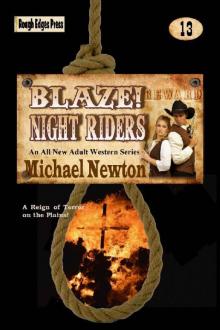 Blaze! Night Riders
Blaze! Night Riders How to Write Action Adventure Novels
How to Write Action Adventure Novels Blaze! Bad Medicine
Blaze! Bad Medicine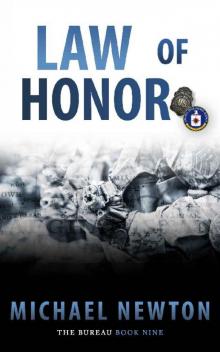 Law of Honor
Law of Honor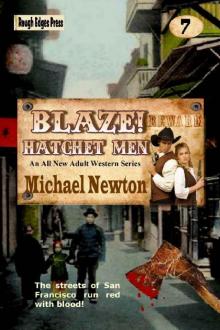 Blaze! Hatchet Men
Blaze! Hatchet Men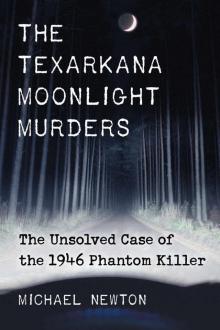 The Texarkana Moonlight Murders
The Texarkana Moonlight Murders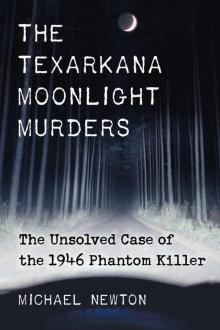 The Texarkana Moonlight Murders: The Unsolved Case of the 1946 Phantom Killer
The Texarkana Moonlight Murders: The Unsolved Case of the 1946 Phantom Killer